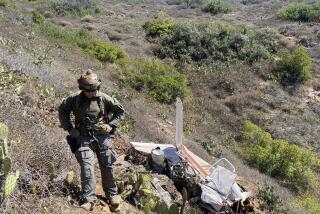FAA Jet Tests El Toro for Use as a Commercial Airport
- Share via
Taking a major step in evaluating El Toro as a commercial airport, the FAA on Wednesday tested departure routes and obstacle clearances at the former Marine Corps airfield using a Learjet.
The test, the Federal Aviation Administration’s first at El Toro since the base was closed two years ago, was ordered by the agency’s aeronautical center in Oklahoma City, which is beginning what officials expect to be a long assessment of El Toro.
The results of the FAA evaluation are considered crucial because of the fierce debate over whether El Toro can safely be converted into an international airport, as the Orange County Board of Supervisors wants.
The county contends that the runways are safe. But anti-airport forces, as well as the nation’s largest pilots union, say nearby mountains and high winds can make takeoffs hazardous.
Critics have also questioned whether the already crowded Southern California skies--with air traffic from more than a dozen airports including Los Angeles International, John Wayne and Long Beach--could support another major airport.
The FAA test Wednesday was to evaluate the county’s proposed departure routes and their distances and altitudes for obstacle clearance, and to test whether the routes are flyable, said Jerry Snyder, a spokesman for the FAA’s Western Pacific region.
The agency used a Learjet 60, a fast but small eight-seat aircraft, with an experienced FAA inspector aboard.
Airport critics were quick to point out that the Learjet 60 hardly qualifies as a commercial jet, but the FAA expressed confidence in the test and the inspector’s ability.
“The thing the public has to understand is that this is not a plane that is used commercially. It’s small and quiet,” said Tom O’Malley, deputy director of a South Orange County anti-airport coalition and retired Marine colonel who flew C-130 aircraft.
The FAA, however, said the size of the plane was irrelevant to Wednesday’s test.
Part of the evaluation involved checking distances and elevations to ensure that the routes are clear of any obstacles and can be used “regardless of weight and size of planes,” Snyder said.
Mark Hansen, an expert with the National Center of Excellence for Aviation Operations Research, said the Learjet 60 is adequate for gathering information on departure routes.
“They can probably do everything they need to with a Learjet,” Hansen said.
FAA evaluations are conducted to ensure that no hills, towers or highway overpasses interfere with departure and landing conditions, Hansen said.
“They want to make sure they can climb safely. Landing isn’t so much of an issue. Departures are different though, because the plane is under a higher load and it’s also limited in how steeply it can climb,” he said.
The jet was sighted about 10:10 a.m. when it cleared the Santa Ana Mountains. It approached Runway 34 with its landing gear down but did not land. It flew at an elevation of about 35 feet and then climbed out to the north.
The aircraft returned an hour later.
The FAA will have the final say over whether an airport is built at El Toro and would provide at least some of the funding. County officials said they had no direct role in the evaluation but said they were pleased that the FAA is beginning to review the proposal.
Critics said they were satisfied with the test because it may prove that El Toro is unsafe for commercial flight. But they expressed disappointment that they were not notified of Wednesday’s test.
“There’s an overall lack of trust by the public toward the county and a lack of respect for the people’s right to know in this whole process,” said Meg Waters, a spokeswoman for the El Toro Reuse Planning Authority, a coalition of eight cities opposed to the airport.
County officials said they were told Friday by the FAA of the possibility of a test but did not learn the exact day and time until Tuesday about 3 p.m. At that point, officials said, they informed the Board of Supervisors and John Wayne Airport.
“We don’t control the FAA or any other federal agency. . . . There’s no conspiracy,” said Rob Richardson, interim El Toro program manager.
The FAA did not know how long the overall evaluation process will take and when the results will become public.
More to Read
Inside the business of entertainment
The Wide Shot brings you news, analysis and insights on everything from streaming wars to production — and what it all means for the future.
You may occasionally receive promotional content from the Los Angeles Times.











